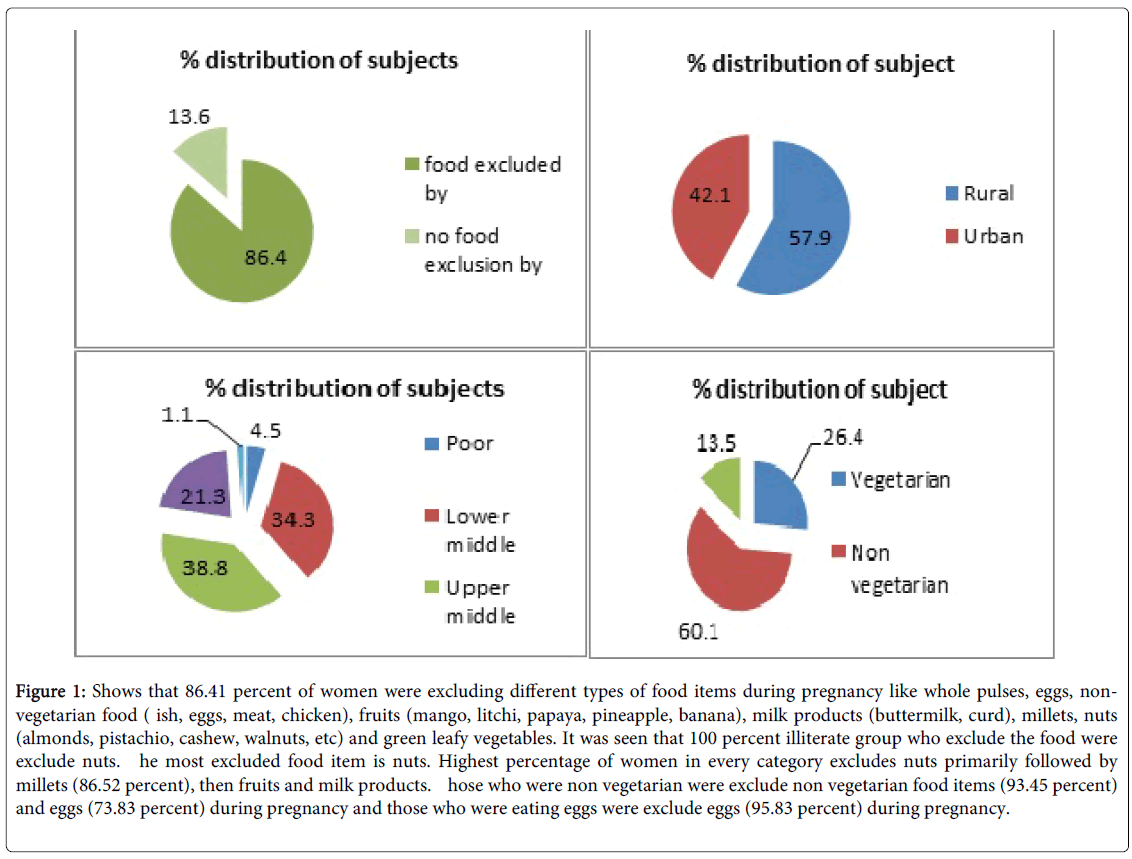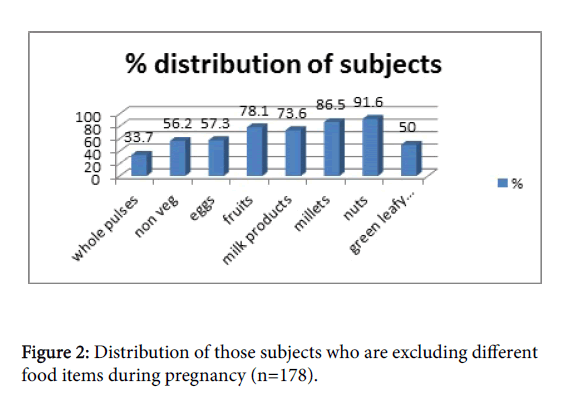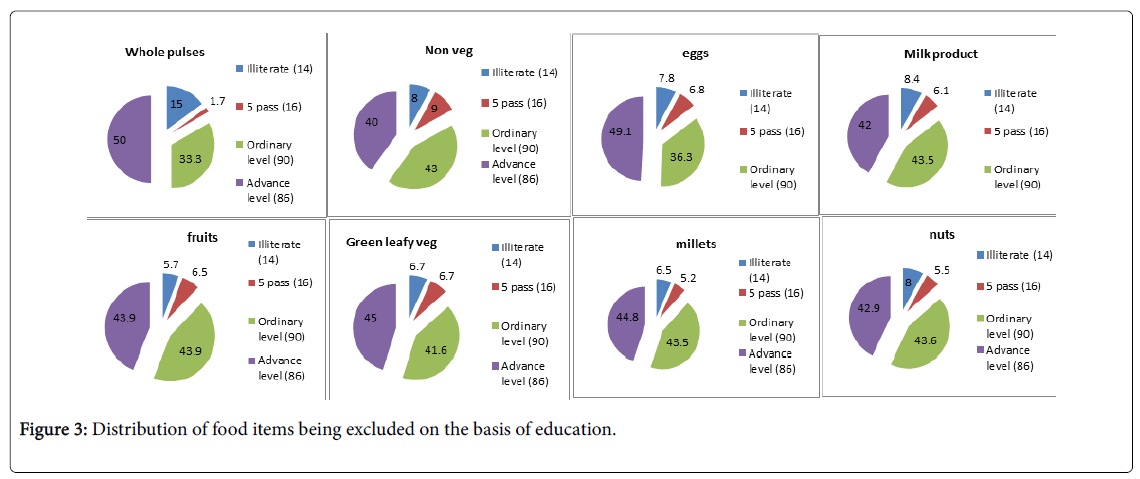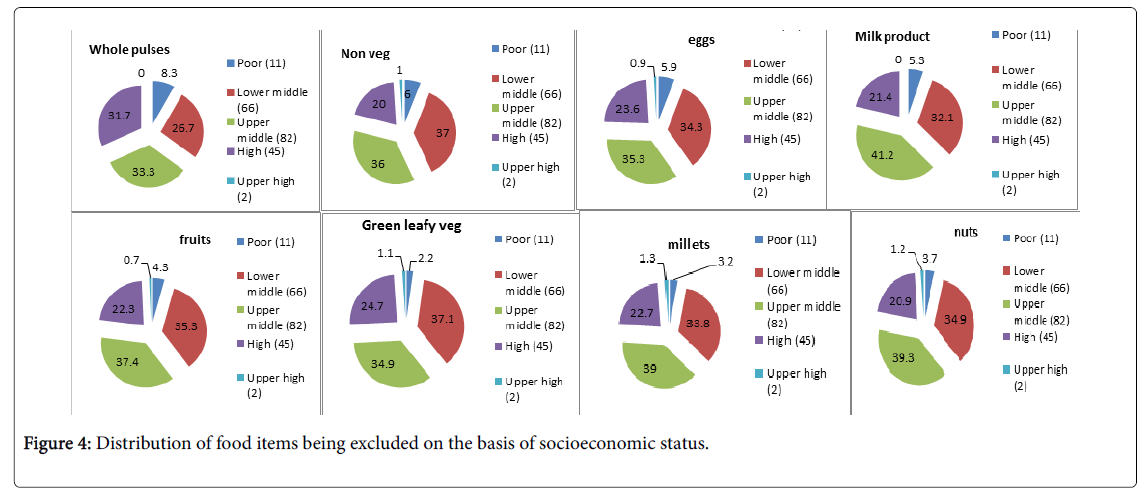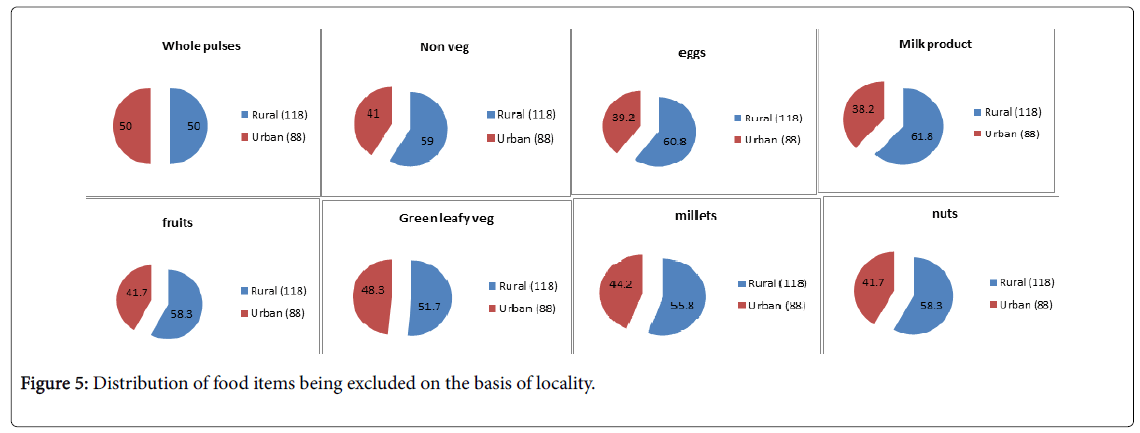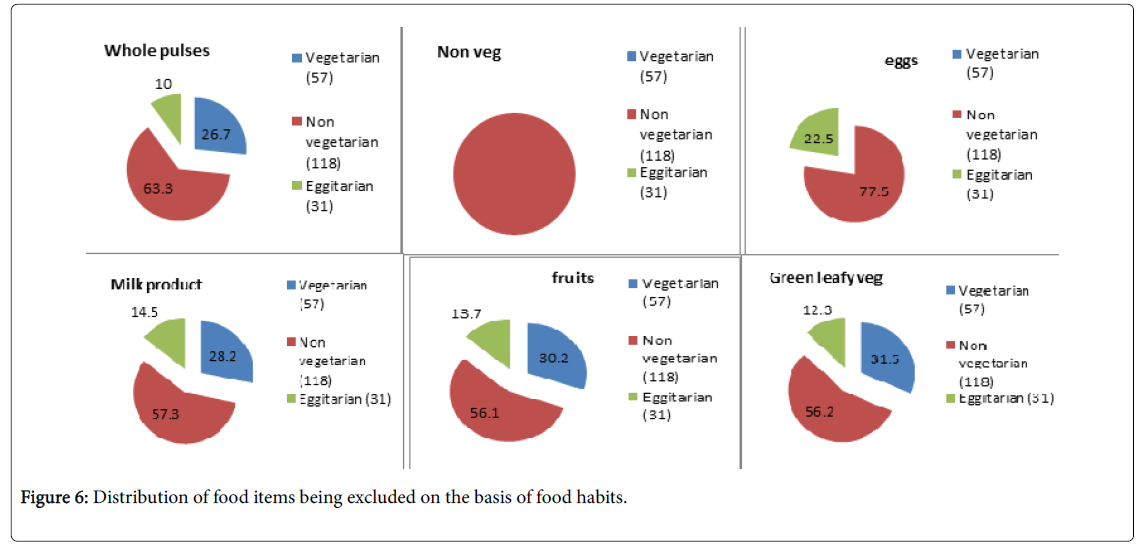Research Article, J Food Nutr Disor Vol: 7 Issue: 5
Factors Influencing the Exclusion of Food during Pregnancy in Uttarakhand
Joshi A* and Kulshrestha K
Department of Food and Nutrition, College of Home Science, GBPUAT, Pantnagar, Uttarakhand, India
*Corresponding Author : Alpana Joshi
Department of Food and Nutrition, College of Home Science, GBPUAT, Pantnagar, Uttarakhand, India
Tel: +91 7534041111
E-mail: alpsjo2100@gmail.com
Received: May 26, 2018 Accepted: July 17, 2018 Published: July 21, 2018
Citation: Joshi A, Kulshrestha K (2018) Factors Influencing the Exclusion of Food during Pregnancy in Uttarakhand. J Food Nutr Disor 7:5. doi: 10.4172/2324-9323.1000253
Abstract
There are multiple reasons for assuring adequate micro nutrient status pre pregnancy and throughout lactation to achieve optimal infant and young child outcomes and maternal health. Multiple micronutrient containing supplements are widely available and after initial survey for adequacy, women should be encouraged to take supplements when their needs are not met by food-based or fortification approaches. Figures, showing distribution of pregnant women according to the education, economic status, locality, food habits and percentage of women who excluding food and further distribution according to the education, socioeconomic status, and locality revealed that a major proportion (87%) of women were excluding some or the other food during pregnancy, out of these 78% were from lower socioeconomic status and also had low level of education. It is concluded from the study that Uttarakhand women who exclude food constitute the major proportions i.e. 87%, and further distribution according to the education, socioeconomic status, and locality revealed that out of these 78 percent were from lower socioeconomic status and
also had low level of education. However no major difference as per location was apparent from the data i.e. in rural or urban women. Major groups of foods being eliminated were nuts, fruits and vegetables and non-veg food like; milk, meat, eggs having greater importance during pregnancy however as these were excluded by women from lower socioeconomic strata the reason may be affordability apart from the reasons given i.e. hotness or cold foods criteria.
Keywords: Micronutrient; Pregnancy
Introduction
During pregnancy most important practice is healthy eating. Good nutrition is essential for mother to meet the added demands of body and of those of growing baby. Since, maternal nutrition plays an important role in pregnancy outcomes; ignorance about its requirement can cause irreversible changes to the health of the newborn. Inadequate dietary intake resulting the malnutrition which is associated with growth failure and cause protein energy malnutrition, during gestation [1] appropriate nutrition is key in meeting increased nutrient demands, Provide energy needed, Prevent or minimize common pregnancy related problems, reduce risk of birth defects, Supply needed nutrients for baby’s growth, Ensure healthy birth weight, Appropriate weight gain of the mother. Study done by Mridula et al. [2] revealed that Mother’s diet should ensure the sufficient nutrient intake and energy for adequate growth of foetus, without affecting the store of mother and tissues to maintain the pregnancy so the proper balanced diet is necessary. Pregnancy is globally associated with cultural rituals and ceremonies.
Traditional beliefs vary according to societies and so practices related to health care in general and regarding harmful as well as beneficial effects of foods for women during pregnancy. These beliefs may not always follow modern biomedical norms of maternal nutrition [3]. The research about food to be included or avoided during pregnancy and the perception of foods as “hot” or “cold” that varies from region to region in India.
The hotness or coolness is not serving temperature of foods or the spices mixed in food, spices are supposed to be hot. The general beliefs about the hot foods are harmful and cold foods beneficial during pregnancy. Because pregnancy generates a state of “hotness,” it is thought to be desirable to attain balance by eating ‘cold’ food. Cold foods are recommended during early pregnancy to avoid miscarriage. Hot foods are roused during the last stages of pregnancy to facilitate the dismissal of the foetus [4].
A study done in Tamil Nadu revealed that the consumption of green leafy vegetables, fruits, dairy product and animal protein were increased during the pregnancy. A significant association was observed between intake of food items and socio-economic factors such as parity, education, family type, family income and visits to health-care services. Some restrictions were also observed in some parts of Tamil Nadu women on items such as papaya, fish, green dhal and pumpkin, and consumed certain home-made foods [5].
As if avoidance of potential food (for whatever reason) does not in itself symbolize a food taboo, actually regular avoidance can turn into a traditional beliefs and ultimately end up as a food taboo [6,7]. In view of this the present study was planned; to know about the different food items being excluded during pregnancy and to understand the factors associated with the excluded food items among women of Kumoan region of Uttarakhand.
Materials and Methods
206 pregnant women age group between 15 to 45 years were selected on the basis of those who completed the 28 weeks of pregnancy and registered in government hospital. The subjects were selected from rural and urban area of three districts of Uttarakhand (Nainital, Udham singh nagar, Bageshwar) two blocks were selected from each districts from Nainital- Ramnagar and Kotabaag, From Udhamsingh Nagar- k. Kashipur and Rudrapur, From Bageshwar- Bageshwar and Garud were selected.
The ASHA (Accredited Social Health Activist) worker contacted who were willingly to help for survey. Pre tested questionnaire was used for data collection [8] scale of Dudeja, et al. [9] was used to assess socio economic status of pregnant women. Information about locality, socioeconomic status, food habits, food exclusion during pregnancy, which provides guidance to mother during pregnancy, different food which was being excluded by the pregnant women was collected (Figure 1). To find out the reason behind the exclusion of foods during pregnancy the focused group discussion were performed in two groups from rural and urban area.
Figure 1: Shows that 86.41 percent of women were excluding different types of food items during pregnancy like whole pulses, eggs, nonvegetarian food (ish, eggs, meat, chicken), fruits (mango, litchi, papaya, pineapple, banana), milk products (buttermilk, curd), millets, nuts (almonds, pistachio, cashew, walnuts, etc) and green leafy vegetables. It was seen that 100 percent illiterate group who exclude the food were exclude nuts. he most excluded food item is nuts. Highest percentage of women in every category excludes nuts primarily followed by millets (86.52 percent), then fruits and milk products. hose who were non vegetarian were exclude non vegetarian food items (93.45 percent) and eggs (73.83 percent) during pregnancy and those who were eating eggs were exclude eggs (95.83 percent) during pregnancy.
Results and Discussion
Distribution of subjects according to food exclusion and no exclusion of food, education, socio economic status, food habits and locality.
The significance of excluding of food during pregnancy depending upon education, socio economic status, locality of pregnant women and guidance through mother, mother in law and relatives. It was evident from (Figures 2 and 3) that education didn’t not in luence the women to exclude food but exclusion of whole pulses, eggs and nonvegetarian items were significantly associated with education of women (p value = <0.05). The guidance by mother in law and relatives was significantly associated (p value= <0.05). Study done in Nairobi, on interviewing pregnant women, they answered that their mother in laws had changed their perceptions in respect to antenatal care (Figures 4 and 5).
They informed that, they were less burdened to practice traditions and beliefs and they felt more comfortable during their pregnancy. Women also revealed that, those perceptions that existed on imposing dietary restrictions on certain food products earlier were changed. For e.g. women were restricted to take less food so as to reduce heaviness in stomach moreover intake of certain food products like curd, lentils, green gram etcetera were considered unhealthy during pregnancy [10]. In the focused group discussion it was tried to find out the reason behind the exclusion of different food items during pregnancy, and the reasons the results summarized in Table 1.
| Food items excluded | Reasons |
|---|---|
| Non veg- meat, fish, chicken | Include in hot food, not specific reason |
| Eggs | It can cause a thin membrane over the infant skin locally called “lechi” |
| Whole pulses | Formation of gas |
| Fruits – mango, litchi, banana, guava | It also form the lechi (thin membrane over the skin) to infant |
| Curd and buttermilk | Same as for fruit and non-veg |
| Millets | Not specific reason |
| Nuts- almonds, groundnuts etc | Hot food can cause abortion |
| Brinjal/green leafy vegetable | Not specific reason |
| Coffee | Hot drink can cause abortion |
| Hot foods - Madua (finger millet), Bhatt (black soyabean), kuttu (buck wheat), gohaut daal (horse gram), chaulai (amaranth), methi (fenugreek), bitter gourd, brinjal, mooli ki sabzi, mango, flesh foods, eggs, milk, dry fruits, Jaggery, spices, chilly, garlic, ginger, bhang (hemp seed), all type of halwa (aate, besan, badam etc) except suji, coffee, gethi (local vegetable),til, ajwain. | Can cause abortion. |
Table 1: List of food items which are being avoided by the respondents during pregnancy.
Revealed that various foods were eliminated from diet during pregnancy the reason being the hotness of food was that it can cause abortion because the pregnancy is the stage of liberating more of heat so it should be maintained through the cold foods. Some example of hot foods are nuts, fruits like mango, papaya, whole pulses, etc. and some other reasons were like consumption of buttermilk and curd supposed to be cold were attributed to cause formation of some membrane which was called “lechi” in local language which can cause discomfort in vaginal part to girl child in later ages.
Conclusion
It is concluded from the study that Uttarakhand women who exclude food constitute the major proportions i.e. 87%, and further distribution according to the education, socioeconomic status, and locality revealed that out of these 78 percent were from lower socioeconomic status and also had low level of education (Figure 6). However no major difference as per location was apparent from the data i.e. in rural or urban women [11]. Major groups of foods being eliminated were nuts, fruits and vegetables and non-veg food like; milk, meat, eggs having greater importance during pregnancy however as these were excluded by women from lower socioeconomic strata the reason may be affordability apart from the reasons given i.e. hotness or cold foods criteria.
References
- Abu-saad K, Fraser D (2010) Maternal nutrition and birth outcomes. Epidemiol Rev. 32: 5-25.
- Mridula D, Mishra CP, Chakraverty A (2003) Dietary intake of expectant mother Indian J Nutr Diet 40: 24-30
- Nag M (1994) Beliefs and Practices about Food during Pregnancy. Economic and Political Weekly Econ Polit Wkly 2427-2438.
- Choudhary UK (1997) Traditional practices of women from India: pregnancy, childbirth, and newborn care. J Obstet Gynecol Neonatal Nurs 26: 533-539.
- Andersen LT, Thilsted SH, Nielsen BB, Rangasamy S (2003) Food and nutrient intakes among pregnant women in rural Tamil Nadu, South India. Public Health Nutr 6: 131-137.
- Harris M (2009) Food and evolution: Toward a theory of human food habits. Temple University Press.
- Simoons FJ (1994) Eat not this flesh: food avoidances from prehistory to the present.
- Aggarwal OP, Bhasin SK, Sharma AK, Chhabra P, Aggarwal K, et al. (2005) A new instrument (scale) for measuring the socioeconomic status of a family: preliminary study. Indian J Community Med 30: 111-114.
- Dudeja P, Bahuguna P, Singh A, Bhatnagar N (2015) Refining a socio-economic status scale for use in community-based health research in India. J Postgrad Med 61: 77.
- Abuya BA, Ciera J, Kimani-Murage E (2012). Effect of mother’s education on child’s nutritional status in the slums of Nairobi. BMC pediatrics 12: 80.
- Mukhopadhyay S, Sarkar A (2009) Pregnancy-related food habits among women of rural Sikkim, India. Public Health Nutr 12: 2317-2322.
 Spanish
Spanish  Chinese
Chinese  Russian
Russian  German
German  French
French  Japanese
Japanese  Portuguese
Portuguese  Hindi
Hindi 